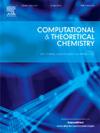基于卟啉的纳米环用于敏感的塔本检测:来自密度泛函理论的见解
IF 3
3区 化学
Q3 CHEMISTRY, PHYSICAL
引用次数: 0
摘要
他奔是一种剧毒神经毒剂,对人类健康和安全以及生态系统构成重大风险。其无味的性质使检测复杂化,突出了迫切需要先进的检测技术来减少潜在的暴露。本研究考察了基于卟啉的纳米结构的传感能力,特别是锌(NRP4Zn4)和镁(NRP4Mg4)结构。利用CAM-B3LYP/6-31G*理论水平的DFT计算,综合分析了它们的几何结构、电子性质、结合能、电子转移数、态密度和HOMO-LUMO分布。结果表明,纳米环与Tabun之间存在明显的相互作用,其电子结构发生了显著变化,表面负电荷密度增加。值得注意的是,结合能和能隙的变化表明,镁结合(NRP4Mg4)结构可以作为Tabun检测的有效传感器。这些发现使NRP4Mg4纳米结构成为开发能够快速灵敏检测Tabun的高效传感器的有希望的候选物。本文章由计算机程序翻译,如有差异,请以英文原文为准。

Porphyrin-based Nanorings for sensitive Tabun detection: Insights from density functional theory
Tabun is a highly toxic nerve agent that poses significant risks to human health and safety, as well as ecological systems. Its odorless nature complicates detection, highlighting the urgent need for advanced detection technologies to mitigate potential exposure. This study investigates the sensing capabilities of porphyrin-based nanorings, specifically Zinc-(NRP4Zn4) and Magnesium-incorporated (NRP4Mg4) configurations. Utilizing DFT calculations at the CAM-B3LYP/6-31G* level of theory, we comprehensively analyzed their geometrical structures, electronic properties, binding energies, electron transfer numbers, density of states, and HOMO-LUMO distributions. The results indicated significant interactions between the nanorings and Tabun, with significant changes in electronic structure and increased negative charge density on their surfaces. Notably, the binding energies and energy gap alterations suggest that Magnesium-incorporated (NRP4Mg4) configurations could serve as effective sensors for Tabun detection. These findings position NRP4Mg4 nanoring structure as promising candidates for developing efficient sensor capable of rapid and sensitive Tabun detection.
求助全文
通过发布文献求助,成功后即可免费获取论文全文。
去求助
来源期刊

Computational and Theoretical Chemistry
CHEMISTRY, PHYSICAL-
CiteScore
4.20
自引率
10.70%
发文量
331
审稿时长
31 days
期刊介绍:
Computational and Theoretical Chemistry publishes high quality, original reports of significance in computational and theoretical chemistry including those that deal with problems of structure, properties, energetics, weak interactions, reaction mechanisms, catalysis, and reaction rates involving atoms, molecules, clusters, surfaces, and bulk matter.
 求助内容:
求助内容: 应助结果提醒方式:
应助结果提醒方式:


